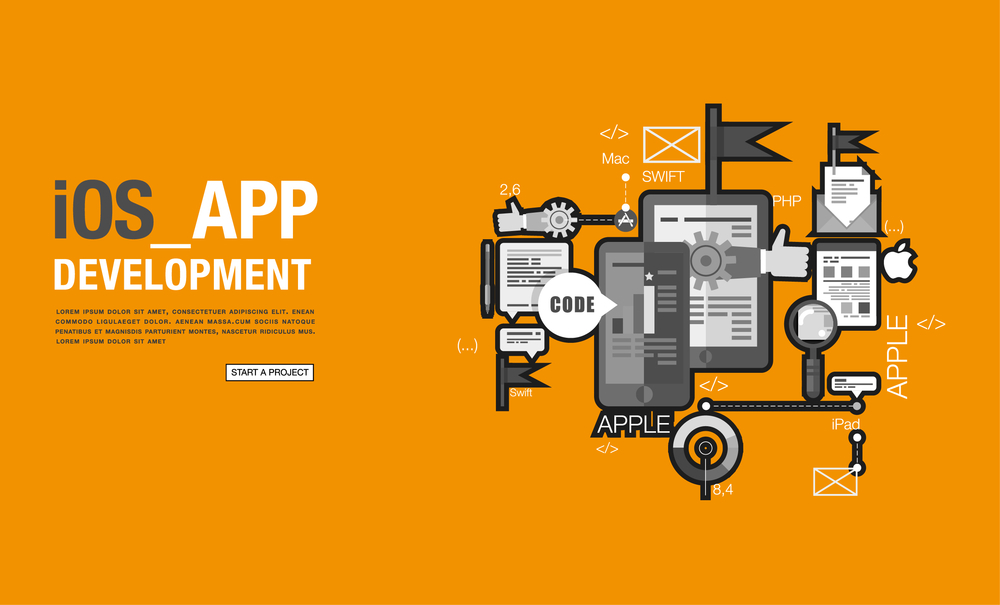development
Enterprises have gone through a drastic change in providing apps development services. Most development companies are changing their path from web development to mobile application development.
The reason behind this is simple, people are increasingly using mobile applications, and companies want to attract customers where they spend most of their time. On average, a person spends 25%, equivalent to 7 hours per day, on their mobile phone.
There would be no use of mobile phones if there would be no apps. Even its existence is futile without applications. Mobile phones now have a much bigger purpose than calling and texting.
They are your entertainment partner, fitness partner, and daily driver. Identify the problem, develop an app with essential features, put it on the phone, and make your life easy. But to bring easiness on the user side, developers have to work hard.
When developing an app for iPhone, their struggle starts with choosing a correct development framework. There are plenty of frameworks available, but they want to choose best to develop best to deliver the best. iOS technology is in a different dimension than Android. The same approach would not lead to a successful build.
The article will share the best iOS app development frameworks of 2021 with their pros and cons to letting you choose the best.
(The order does not reflect well to an average framework or vice versa. They are just numbered.)
- React Native
A veryrenownedopen-source framework by Facebook. React Native is based on JavaScript, highly efficient, and famous for cross-platform app development. With that, you can build Android and iOS apps. It significantly reduces the development time and lets the developer build a robust and powerful application.
The use of javascript here makes things more straightforward to move from one project to another. Also, the developers’ community of this framework is vast and responsive. As industry giant Facebook standing behind this framework, you can expect a detailed response and documentation from it.
Walmart, Facebook, and Skype are prominent apps developed on this framework. To prove the framework’s potential, Facebook built its own application on it, which today has billions of downloads. The application’s performance is needless to mention here as everyoneis the witness being the user of it.
Pros:
- Support Android and iOS development both.
- Reusable code base.
- Highly efficient development.
- Less memory and resource consumption.
- Reusable components.
Cons:
- Custom modules are challenging to develop.
- Users face some challenges with navigation components.
- Flutter
Created and backed by Google, Flutter is the most popular open-source hybrid framework. It is highly intuitive (Thanks to the Google team) and allows programmers to build a native mobile application with one code-base. It means that by writing a code for once, you will create two near to native applications, one for Android and the other for iOS, simultaneously.
Flutter was released in 2017. Since its inception, developers have embraced it in such a way that now it is the best platform for developing resource-friendly applications for iOS and Android platforms. Not limited to that, flutter also supports development for smart tv, tablets, smart panels, smartwatches, and other IoT devices.
Pros:
- Open-source platform by Google.
- Supports real-time updates. No need for the relaunch to amend or change anything.
- Customization is effortless as the platform offers a bundle of widgets.
- The default development language is Dart for all fuchsia Os-based apps.
Cons:
- Community is not grown.
- The application size is significantly large.
- As it is a comparatively new framework, the advanced tools are not free to use.
- Does not support web-driven applications.
- Only available for mobile app development.
- Framework7
Offering an experience like native applications, Framework7 is another famous platform for developing iOS and Android applications. The framework is open-source, which means it is free to use.
The good thing is that if a developer has command over HTML, CSS, and JS, then Framework7 is relatively easy to adopt. Additionally, it also has support for React, Vue.js, and Svelte.
The user interface elements which this framework provides are very aesthetical. List view, popup, side panels, action sheet, and other valuable features are included in this framework. All these components tend to fasten the development process.
Pros:
- No third-party library dependency. It consists of its own custom DOM7.
- It can also be utilized with React and Angular frameworks.
- Bower for faster app development
Cons:
- Poor documentation.
- Developers’ online community for this platform is relatively small.
- If you are not a fan of HTML5, then it is not for you.
- Ionic
Ionic is an HTML5 based open-source development framework. This framework’s primary focus is on the app’s feel and aesthetics, or, we can say, user interface.
Ionic also allows applications to be developed in a cross-platform environment. It utilizes web-based technologies like HTML, JS, and CSS and is a fusion of mobile and web app development frameworks. If the time and budget are your top priority, this framework is the right choice.
Pros:
- Easy to maintain.
- Open-source and free to use.
- Support for the angular framework.
- Reliable and easy to scale.
Cons:
- Performance is average.
- In-app navigation is not consistent.
- The trade-off in the user experience.
- PhoneGap
PhoneGap is another famous player in the development framework team. PhoneGap’s core is based on CSS3 and HTML5, which can access the phone’s hardware like a camera, GPS sensor, and accelerometer.
JavaScript is also there to support the backend application’s logic, and this is a competitive advantage for PhoneGap as JavaScript is the famous and essential ingredient in programming.
Like every other cross-platform and hybrid framework, PhoneGap also allows users to write a single code and use it on multiple platforms as a native application. The Adobe system was standing behind the PhoneGap, but now Apache has adopted this framework to maintain it. So, now it is an apache Cordova distribution.
Wikipedia, Buildr, and Paylution are some apps developed on PhoneGap.
Pros:
- Not hard to use.
- No investment is required.
- Work very closely with the APIs
- Suitable for both small and big complex application development.
Cons:
- The system may require more UI widgets.
- Against other development platforms, performance is not optimal.
Final Verdict
A framework is a driver for any IOSApp Development Company, which may give them abumpy drive or a fast, smooth drive.Every company must understand that one framework is not suitable for all development purposes. Every IDE has its advantages and disadvantages, which are mentioned above with every framework. The choice should always be made depending on the project’s requirement.
The framework list does not end here. There are numerous others, but these are the ones that are currently in demand and optimized for today’s market development needs. Some are focused on offering materialistic design and minimal user interface, while some are focused on performance. Again, it depends on the user requirement. So, choose wisely.
Hopefully, the article was able to deliver some information to you on choosing the proper development framework for iOS applications.
With that said, keep coding!




